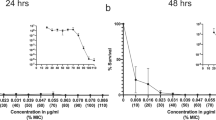Abstract
CLINICAL isolates of bacteria that have gained resistance to β-lactam antibiotics (penicillins, cephalosporins and related compounds) often arise by the acquisition of a plasmid that produces a β-lactamase1,2. An increase in β-lactamase activity has also been shown to cause resistance in some mutants isolated in the laboratory3. In other cases, β-lactamase activity is not the cause of resistance and, at least in Gram-negative bacteria, alteration of the cell envelope resulting in decreased penetration of the antibiotic to the targets responsible for lethality in the cytoplasmic membrane has been proposed3,4. For several groups of antibiotics resistance has been shown to occur by a decrease in the affinity of the target for lethality for the antibiotic5–9 but, although this mechanism has been suggested as a possible cause of resistance to β-lactam antibiotics, no examples have been reported. The lethality targets for β-lactam antibiotics in Escherichia coli have recently been identified and I report here the characterisation of a mutant that has gained resistance to some β-lactams by a decrease in the affinity of such a target.
Similar content being viewed by others
References
Richmond, M. H. & Curtis, N. A. C. Ann. N.Y. Acad. Sci. 235, 553–567 (1974).
Rolinson, G. N. Proc. R. Soc. B 179, 403–410 (1971).
Boman, H. G., Nordstrom, K. & Normark, S. Ann. N.Y. Acad. Sci. 235, 569–586 (1974).
Rodriguez, W. & Saz, A. R. Antimicrob. Ag. Chemother. 7, 788–792 (1975).
Davis, B. D. & Maas, W. K. Proc. natn. Acad. Sci. U.S.A. 38, 775–785 (1952).
Sirotnak, F. M., Donati, G. & Hutchison, D. J. J. biol. Chem. 239, 4298–4302 (1964).
Babinet, C. & Condamine, H. C.r. hebd. Séanc. Acad. Sci., Paris 267, 231–232 (1968).
Ozaki, M., Mizushima, S. & Nomura, M. Nature 222, 333–339 (1969).
Gellert, M. et al. Proc. natn. Acad. Sci. U.S.A. 74, 4772–4776 (1977).
Blumberg, P. M. & Strominger, J. L. Bact. Rev. 38, 291–335 (1974).
Spratt, B. G. Science Prog. Lond. 65, 101–128 (1978).
Spratt, B. G. & Pardee, A. B. Nature 254, 516–517 (1975).
Spratt, B. G. Proc. natn. Acad. Sci. U.S.A. 72, 2999–3003 (1975).
Spratt, B. G., Jobanputra, V. & Schwarz, U. FEBS Lett. 79, 374–378 (1977).
Tamaki, S., Nakajima, S. & Matsuhashi, M. Proc. natn. Acad. Sci. U.S.A. 74, 5472–5476 (1977).
Suzuki, H., Nishimura, Y. & Hirota, Y. Proc. natn. Acad. Sci. U.S.A. 75, 664–668 (1978).
Spratt, B. G. Antimicrob. Ag. Chemother. 11, 161–166 (1977).
Spratt, B. G., Jobanputra, V. & Zimmermann, W. Antimicrob. Ag. Chemother. 12, 406–409 (1977).
Laskey, R. A. & Mills, A. D. Eur. J. Biochem. 56, 335–341 (1975).
Author information
Authors and Affiliations
Rights and permissions
About this article
Cite this article
SPRATT, B. Escherichia coli resistance to β-lactam antibiotics through a decrease in the affinity of a target for lethality. Nature 274, 713–715 (1978). https://doi.org/10.1038/274713a0
Received:
Accepted:
Issue Date:
DOI: https://doi.org/10.1038/274713a0
- Springer Nature Limited
This article is cited by
-
Resistance to β-lactam antibiotics by re-modelling the active site of an E. coli penicillin-binding protein
Nature (1985)
-
Sulfazecin and isosulfazecin, novel β-lactam antibiotics of bacterial origin
Nature (1981)
-
Bacillus megaterium resistance to cloxacillin accompanied by a compensatory change in penicillin binding proteins
Nature (1979)





